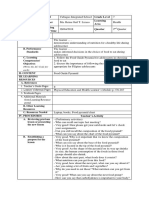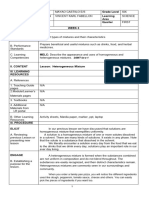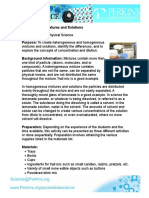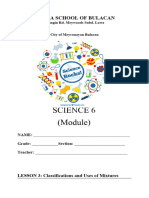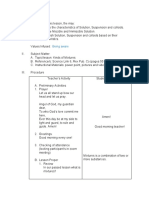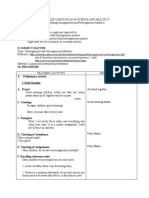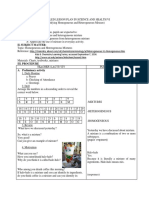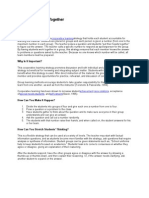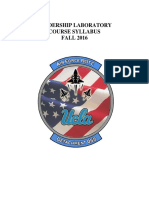Hetero Mix Lesson
Hetero Mix Lesson
Uploaded by
MarvinGarciaCopyright:
Available Formats
Hetero Mix Lesson
Hetero Mix Lesson
Uploaded by
MarvinGarciaOriginal Description:
Copyright
Available Formats
Share this document
Did you find this document useful?
Is this content inappropriate?
Copyright:
Available Formats
Hetero Mix Lesson
Hetero Mix Lesson
Uploaded by
MarvinGarciaCopyright:
Available Formats
Less
on
plan
Topic:
Teacher/s
School
Class
Subject
Date
Duration
Tr. Belen Garcia and Tr. Kenisha Reyes
August Pine Ridge Roman Catholic School
Standard IV
Science
February 15-19, 2016
45 minutes
1 lessons
Lesson Content
Key Vocabulary
Heterogeneous Mixture
A mixture can also result in two or more phases clearly separated by boundaries.
Very often, the separation can be clearly seen by the eye. A heterogeneous mixture
is one that does not have uniform properties and composition. Take a look at a bowl
of cereal with nuts. A spoon full will surely have different number of nuts than a
second spoonful taken at random. Another exampletake some sea-sand into your
palms. Look at it closely and you will notice that some sand particles are bigger
than others, and the colors of some particles may be different too. They are NOT
uniform in anyway!
Heterogeneous mixtures include colloids, emulsions or suspensions.
Suspension
A suspension is a heterogeneous mixture of a liquid and a solid. The solid usually
does not dissolve, and can be very visible to the eye. Sometimes the solids are
heavy, and large enough for sedimentation (particles settling down in layers) in the
container holding it. Unlike colloids, regular agitation is needed to keep mixture
fairly mixed.
An example of a suspension is a mixture of sand and water.
Emulsion:
An emulsion is a suspension of a liquid within another liquid. An oil and vinegar
salad dressing is a good example of an emulsion, as is the fat within breast milk.
Butter, margarine and mayonnaise are also good examples of emulsions, as fats
continually surround droplets of water. (oil and water)
Some good characteristics of suspensions are:
Mixtures: are physical
combinations of pure
substances that have no
definite or constant
composition
Composition: the way in
which a whole or mixture
made up.
Suspension- A suspension
is a heterogeneous mixtur
of a liquid and a solid
Emulsion- is a suspension
of a liquid within another
liquid
Colloids- a mixture that is
uniform with the naked ey
but in reality the solute is
not completely dissolved
1. It is cloudy (not as clear as a solutions).
2. It can be filtered.
3. The larger particles settle at the bottom.
4. It is a mixture of two phases.
Colloids
A colloid (also known as colloidal dispersion) may look like a homogenous mixture,
because the mixture looks very uniform. Under a bit of magnification, the solute is
not completely dissolved, and the particles are big enough, making the entire
mixture cloudy.
For exampleMayonnaise is a mixture of egg yolk, vinegar and lemon juice. It is
whisked smoothly to a degree that it feels so smooth, but under a microscope, the
solute is not completely dissolved. Examples of colloids are Milk, Mayonnaise,
Butter, Egg Whites.
References: http://www.dummies.com/how-to/content/how-to-distinguish-puresubstances-and-mixtures.html
https://www.youtube.com/watch?v=KRvsPh4pU90
http://www.eschooltoday.com/science/elements-mixtures-compounds/types-ofmixtures.html
Monday
Differentiating
between
Solution,
Emulsion and
Suspension
Objectives- Through experiments and a video students will be able to
1. Differentiate between a solution, suspension, emulsion
2. Record their discoveries on a table
3. Explain what is a solution or colloid and emulsion
4. Place Cooperate with their group members to complete the tasks given
Introduction
Have a quick review of what a mixture is and the different types by
playing pass the paper ball with them
Place the word Mixture on the board
Elicit the two types of Mixtures they learned last class
Materials
3 Dixie cups,3 plastic spoons, salt
black pepper, consume, soy sauce,
melted butter, cool-aid, cooking oil
etc..
Development
Draw children attention on the second type of mixtures
( Heterogeneous mixtures)
Explain to children that Heterogeneous mixtures can include 3
types of mixtures ( suspension, emulsion, colloids)
Present children with a short video explaining the 3 mixtures.
https://www.youtube.com/watch?v=b3HS_woWaJQ
Class setting
Whole class teaching
Pairs
Grouping
Peer to peer
Outdoors activity
Individual work
Other
Elicit from children what they understood from the video
Deduce the meaning s for each as class and give an example.( can
be the ones from the video)
Have children get in groups of 4 or 5 and have them conduct mini
experiments.( guide students throughout)
place instructions on the board
they will draw table labelled (emulsion, solution, suspension)
They will do one mixture at a time
they will categorize the mixture as either a suspension, solution or
a emulsion
they will record this in their table
after experiment have students sit together and write what they
discovered
Conclusion
students will be placed in pairs to answer the following questions:
In your own words explain what is a :
emulsion
suspension
solution
Give an example of each
Assessment Strategy
Class discussion, participation,
experimenting, recording,
presenting
Assignments
Strength:
Weakness:
Plan of improvement:
You might also like
- Science 6 - Q1 - Module1 - Lesson1 - Describing MixturesDocument29 pagesScience 6 - Q1 - Module1 - Lesson1 - Describing MixturesRose Merie Joy Solmia80% (30)
- LS2 Modules With Worksheets (Mixture)Document17 pagesLS2 Modules With Worksheets (Mixture)Ronalyn Maldan100% (1)
- DLP - Health 7 - Food Guide PyramidDocument3 pagesDLP - Health 7 - Food Guide PyramidMa. Reina Gail T. Lizaso50% (2)
- Creative CurriculumDocument24 pagesCreative CurriculumBasikal Tua100% (1)
- Types of MixturesDocument2 pagesTypes of MixturesTerence FocasanNo ratings yet
- Module #3 Classifications and Formation of Mixtures (New)Document9 pagesModule #3 Classifications and Formation of Mixtures (New)Bryan SorianoNo ratings yet
- UntitledDocument6 pagesUntitledNoel Blaza Jr.No ratings yet
- s6q1w2d4 5Document4 pagess6q1w2d4 5Vincent Karl FabellonNo ratings yet
- Grade 6: Unit 2: MixtureDocument43 pagesGrade 6: Unit 2: MixtureEmylie Alvarez LantoriaNo ratings yet
- G6Q1W5 6Document38 pagesG6Q1W5 6Shiella Mariz BinotapaNo ratings yet
- For CO1Document3 pagesFor CO1rossana rondaNo ratings yet
- COLLOIDSDocument15 pagesCOLLOIDSISRAEL VENIEGASNo ratings yet
- For Demonstratgrade 6 PPT - Science - Q1 - Lesson 1.pptx Autosaved 1Document33 pagesFor Demonstratgrade 6 PPT - Science - Q1 - Lesson 1.pptx Autosaved 1NiwaHisokaNo ratings yet
- 5E Lesson PlanDocument3 pages5E Lesson Plancorrzz owthreeNo ratings yet
- Subject: Chemistry: Topic: Types of MixturesDocument15 pagesSubject: Chemistry: Topic: Types of MixturesPATRICIA BROOKSNo ratings yet
- Unit DDocument18 pagesUnit DVenkateswara Rao DoodalaNo ratings yet
- Unit 4 - Solutions: 5 WeeksDocument3 pagesUnit 4 - Solutions: 5 WeeksToh YangNo ratings yet
- Mixtures and Solutions Target Subject: Physical Science Purpose: To Create Heterogeneous and HomogeneousDocument3 pagesMixtures and Solutions Target Subject: Physical Science Purpose: To Create Heterogeneous and HomogeneousMely CarinoNo ratings yet
- Q1 Sci DLP W1D4 JheallyDocument4 pagesQ1 Sci DLP W1D4 JheallyJheally L. OrlandaNo ratings yet
- Apperance and Uses of Uniform orDocument11 pagesApperance and Uses of Uniform orJean BagtasNo ratings yet
- Homogenous and Heterogenous MixturesDocument33 pagesHomogenous and Heterogenous MixturesJhoewil QuintuaNo ratings yet
- SolutionsDocument40 pagesSolutionsELLEN B.SINAHONNo ratings yet
- Lesson 1 Homogeneous and Heterogeneous MixturesDocument28 pagesLesson 1 Homogeneous and Heterogeneous MixturesFlorenda Sorilla SampianoNo ratings yet
- Mixtures Lesson PlanDocument2 pagesMixtures Lesson PlanReah GumbsNo ratings yet
- Substance and Mixture: Module 2 - Grade 7 ScienceDocument9 pagesSubstance and Mixture: Module 2 - Grade 7 ScienceJoefrey Pujadas BalumaNo ratings yet
- Preparation and Separtion of MixturesDocument46 pagesPreparation and Separtion of MixturesJane Heart Manuel100% (1)
- q1_l4_solutions, Colloids, And SuspensionsDocument48 pagesq1_l4_solutions, Colloids, And SuspensionsBRENDA ROSE HungNo ratings yet
- Activity Sheet in Science VIDocument7 pagesActivity Sheet in Science VIARMELA V. MANONGSONGNo ratings yet
- 1st Quarter Lesson 8 Describe what is a heterogeneous mixtureDocument4 pages1st Quarter Lesson 8 Describe what is a heterogeneous mixturewinston.retiroNo ratings yet
- Science 6-Q1-M4Document16 pagesScience 6-Q1-M4John Philip LegaspiNo ratings yet
- Module #3 Classifications and Formation of MixturesDocument11 pagesModule #3 Classifications and Formation of MixturesBryan Soriano100% (1)
- MCD Lesson Plan 2022 by SaharaDocument3 pagesMCD Lesson Plan 2022 by SaharaLing Macabando ShariefNo ratings yet
- Chemistry Week 3Document4 pagesChemistry Week 32jai-Gavin Herbert [temporary]No ratings yet
- Lesson Plan Kinds of MixturesDocument7 pagesLesson Plan Kinds of MixturesPrecious Rona Salinas SelomenNo ratings yet
- I. Objectives:: Kids & Chemistry Learning Series, Accessed September 7, 2006Document3 pagesI. Objectives:: Kids & Chemistry Learning Series, Accessed September 7, 2006Leah M. BandelariaNo ratings yet
- Experimentation Appearance of Mixtures Formed EditedDocument37 pagesExperimentation Appearance of Mixtures Formed EditedVien Lester FloresNo ratings yet
- Q1 PPT Science W5Document60 pagesQ1 PPT Science W5mary ann valdezNo ratings yet
- Lesson Week 6 Solution RealDocument8 pagesLesson Week 6 Solution Realhsam.patriciaroyoNo ratings yet
- DLP SCIENCE AND HEALTH IV Identifying Homogeneous and Heterogeneous MixtureDocument4 pagesDLP SCIENCE AND HEALTH IV Identifying Homogeneous and Heterogeneous MixtureROMAR ALLAPITAN ENORNo ratings yet
- ELECCION DLP in SCIENCE 6Document8 pagesELECCION DLP in SCIENCE 6Sharlene Jane Chavez EleccionNo ratings yet
- Sci6 Q1 Week1Document55 pagesSci6 Q1 Week1farah.bonusNo ratings yet
- Module #2 Identifying and Forming MixturesDocument5 pagesModule #2 Identifying and Forming MixturesBryan SorianoNo ratings yet
- Science 6 w2Document13 pagesScience 6 w2Lariza LorenoNo ratings yet
- Colloids: Describe The Characteristics and Uses of Simple ColloidsDocument18 pagesColloids: Describe The Characteristics and Uses of Simple Colloidscatherine renanteNo ratings yet
- Q1 PPT Science W3Document56 pagesQ1 PPT Science W3mary ann valdezNo ratings yet
- Science MattersDocument2 pagesScience MattersJewel Alayon CondinoNo ratings yet
- Sci6 - q1 - m1 - Appearance and Uses of MixturesDocument26 pagesSci6 - q1 - m1 - Appearance and Uses of MixturesChelsea UysonNo ratings yet
- Mixtures 101Document2 pagesMixtures 101api-293084509No ratings yet
- 1st Quarter Lesson 9 Describe what a suspension isDocument5 pages1st Quarter Lesson 9 Describe what a suspension iswinston.retiroNo ratings yet
- 1st Quarter Lesson 10 Show That a Suspension is a Heterogeneous MixtureDocument4 pages1st Quarter Lesson 10 Show That a Suspension is a Heterogeneous Mixturewinston.retiroNo ratings yet
- A Detailed Lesson Plan in Grade 6 ScienceDocument10 pagesA Detailed Lesson Plan in Grade 6 ScienceMaria Daniela ViduyaNo ratings yet
- Chem M7 SolutionsDocument28 pagesChem M7 SolutionsRosanna Lombres67% (3)
- Chem1 Homo&Heterogenous RubyDocument7 pagesChem1 Homo&Heterogenous RubySheena Dominique Gerardino TimbadNo ratings yet
- A Detailed Lesson Plan in Science and HeDocument3 pagesA Detailed Lesson Plan in Science and HeSwiit HarrtNo ratings yet
- DLP Science 6 Week 1Document10 pagesDLP Science 6 Week 1RjVValdezNo ratings yet
- Science q1 w2 Differentiating Solute From SolventDocument22 pagesScience q1 w2 Differentiating Solute From SolventMallen MallenNo ratings yet
- Science6 - Q1-WK-1 FOR STUDENTDocument14 pagesScience6 - Q1-WK-1 FOR STUDENTMaricar Escarsa Villanueva-MinoyNo ratings yet
- Chemistry Grade 12-Presentation1Document9 pagesChemistry Grade 12-Presentation1Nigatu MAmo100% (1)
- Oil and Water Won't Mix and Other Mixture Separation Techniques - Chemistry Book for Kids 8-10 | Children's Chemistry BooksFrom EverandOil and Water Won't Mix and Other Mixture Separation Techniques - Chemistry Book for Kids 8-10 | Children's Chemistry BooksNo ratings yet
- The Big Chemistry Book on Solutions - Chemistry for 4th Graders | Children's Chemistry BooksFrom EverandThe Big Chemistry Book on Solutions - Chemistry for 4th Graders | Children's Chemistry BooksNo ratings yet
- SOPs For Reproduction of M. ANISOPLIAEDocument26 pagesSOPs For Reproduction of M. ANISOPLIAEMarvinGarciaNo ratings yet
- Calendar of Activities For Sugarcane ProducersDocument10 pagesCalendar of Activities For Sugarcane ProducersMarvinGarciaNo ratings yet
- Industrial RevolutionDocument22 pagesIndustrial RevolutionMarvinGarciaNo ratings yet
- (D) Used Indulgences As A Fund-Raising DeviceDocument16 pages(D) Used Indulgences As A Fund-Raising DeviceMarvinGarciaNo ratings yet
- Industrial RevolutionDocument56 pagesIndustrial RevolutionMarvinGarcia0% (1)
- Iwm ReportDocument6 pagesIwm ReportMarvinGarciaNo ratings yet
- Frog Hopper Monitoring ResultsDocument1 pageFrog Hopper Monitoring ResultsMarvinGarciaNo ratings yet
- DIAMOND TRAPS DATA FormDocument18 pagesDIAMOND TRAPS DATA FormMarvinGarciaNo ratings yet
- Food Chain BackgroundDocument4 pagesFood Chain BackgroundMarvinGarciaNo ratings yet
- Orange Walk - Zone 3 # Assn Test GRP Branch GRP Codegrp Name ID FarmerDocument2 pagesOrange Walk - Zone 3 # Assn Test GRP Branch GRP Codegrp Name ID FarmerMarvinGarciaNo ratings yet
- Role Model Worksheet: NameDocument2 pagesRole Model Worksheet: NameMarvinGarciaNo ratings yet
- Rules and Responsibilities of Lab TechnicianDocument1 pageRules and Responsibilities of Lab TechnicianMarvinGarciaNo ratings yet
- IepDocument8 pagesIepapi-297768775100% (2)
- Teaching Methodologies in Inclusive ClassroomDocument15 pagesTeaching Methodologies in Inclusive Classroomsimba 2020No ratings yet
- Paper 4h May 2004 Solutions Edexcel IgcseDocument25 pagesPaper 4h May 2004 Solutions Edexcel IgcseZanfalawy BashaNo ratings yet
- Numbered Heads Together Wati PunyaDocument6 pagesNumbered Heads Together Wati Punyarahmiati khamaltNo ratings yet
- TA Plan For TeachersDocument2 pagesTA Plan For TeachersShiela Mae F. MaraguinotNo ratings yet
- Kendriya Vidyalaya Bengdubi Walk in InterviewDocument5 pagesKendriya Vidyalaya Bengdubi Walk in InterviewAbhinav tiwariNo ratings yet
- LLAB Syllabus Fall 2016 Det 055Document10 pagesLLAB Syllabus Fall 2016 Det 055Cathy HurtadoNo ratings yet
- BranchesofGovernment PDFDocument8 pagesBranchesofGovernment PDFAnonymous dvQ2leqNo ratings yet
- Ivan Illich (Deschooling)Document2 pagesIvan Illich (Deschooling)Banahene GeorgeNo ratings yet
- Should Cellphones Be Allowed in School?Document2 pagesShould Cellphones Be Allowed in School?Nalie Cortez100% (1)
- Dialogic Reading Lesson PlanDocument4 pagesDialogic Reading Lesson Planapi-315723475No ratings yet
- Hip Launching PamphletDocument2 pagesHip Launching PamphletAzimmahNo ratings yet
- Research 1-3. Revsed Edition HhahaDocument23 pagesResearch 1-3. Revsed Edition HhahaPatricia Vea Mae MalangisNo ratings yet
- 45second SampleDocument39 pages45second SamplePradeep SahooNo ratings yet
- Borang Permohonan Biasiswa Samling Scholarship Application FormDocument4 pagesBorang Permohonan Biasiswa Samling Scholarship Application FormJom StadiNo ratings yet
- Supreme Pupil Government Action PlanDocument6 pagesSupreme Pupil Government Action PlanJay Jay Pastrana100% (1)
- Resume of Kelly SweeneyDocument3 pagesResume of Kelly SweeneyKelly Gilson SweeneyNo ratings yet
- ECD A SchemeDocument68 pagesECD A SchemePercy100% (3)
- They Will Call Us. They Will Not Call Us. Will They Call Us?Document19 pagesThey Will Call Us. They Will Not Call Us. Will They Call Us?FernEspinosaNo ratings yet
- Revised Idt 7061 - Final Exam ReflectionDocument7 pagesRevised Idt 7061 - Final Exam Reflectionapi-253655860No ratings yet
- An Assessment Tool That Measures Student Achievement Related To Phonics Is DIBELSDocument4 pagesAn Assessment Tool That Measures Student Achievement Related To Phonics Is DIBELScaleb mwanziaNo ratings yet
- ReflectionsDocument3 pagesReflectionsapi-197408062No ratings yet
- Scheme of Work - P3Document7 pagesScheme of Work - P3weakcry23100% (1)
- Consolidated Teachers Individual Plan For Professional Development SCHOOL YEAR 2020-2021Document2 pagesConsolidated Teachers Individual Plan For Professional Development SCHOOL YEAR 2020-2021Anicadlien Ellipaw IninNo ratings yet
- Test Unit 1Document2 pagesTest Unit 1Maguis RomaniNo ratings yet
- Learning Styles Principles - NotesDocument5 pagesLearning Styles Principles - NotesJun Rinion TaguinodNo ratings yet
- Original Contribution Angelica Burns American College of EducationDocument10 pagesOriginal Contribution Angelica Burns American College of EducationAngelica BurnsNo ratings yet
- The Seven Engagement Factors PowerpointDocument12 pagesThe Seven Engagement Factors Powerpointapi-258575318No ratings yet


